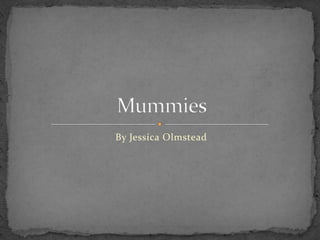Mummies
- 2. ? Where to find Mummies ? Mummification Intentional ? Mummification Accidental ? Burial Grounds ? Types of People Mummified ? Personal Reflection ? Bibliography
- 3. ? Mummies vary in location, across the Earth, due to natural and accidental mummification. ? Peru, China, Egypt, and Italy are the most prominent areas to find mummies. Home
- 4. In Egypt, embalmers would mummify the dead so that the dead person could successfully survive in the afterlife. Royalty would often be buried with their favorite servants and pets. Also, their tombs contained food, gold, and a ship to gain them safe passage through the river of death. Next
- 5. Embalming Wrapping The first step of Starting with the neck and mummification is to wash head, the body is wrapped. the body with water from The mummy will wear a the Nile. Then you remove sacred amulet. After the major organs, such as the book of the dead is lungs and heart, and place read, the body is them in jars. The body will completely wrapped and dry out for 40 days. After put into its first coffin then 40 days, the embalmers the second. The funeral is will cover the body with held and the sweet smelling oils, and mummy, completely stuffed with dry items. dressed, will be put in the sarcophagus, then the Next tomb.
- 6. ? In other parts of the world mummification was also used as a sacred act. The Buddhists would starve themselves for three years, and would be surrounded by candles until they dried out from the heat. The body would mummify itself and they would put the body in a tomb. In South America, the Paracas would bundle the body into a seated position and move them to a huge chamber, called Necropolis. These chambers had parrots, deer, and foxes. Home
- 7. ? Many times, nature has led to people dying and their bodies being preserved for years. Glaciers, earthquakes, mudslides, volcanic eruptions, and tar pits have led to thousands of bodies to be mummified. Next
- 8. ? Dinosaurs trapped in tar pits would leave excellent fossils ? When Mount Vesuvius erupted in Italy, the cowering victims were mummified into the crevices of buildings Home
- 9. Burial Grounds In Egypt, mummies were placed in tombs, such as this. Pyramids were erected for the Pharaoh's tomb. Home
- 10. From monks to Pharaohs, many different people have been mummified. Cats, dogs, and horses have been preserved for years. By mummifying, the body will stay intact and can be used for research. Home
- 11. ? In doing this power point, I learned a lot about using the power point program. At first, I didnĄŊt know where the background designs were but finally found them. Also I learned to actually look at the tabs, they are quite useful. But the most interesting thing I learned was that not only the Egyptians used mummification. Nature uses it to preserve our history. Home
- 12. ? ? Ancient Egyptian Pet Mummies." Intense Zone. Web. 6 Feb 2010. <http://intense-zone.com/wp- content/uploads/Ancient_Egyptian_Pet_Mummies_01.jpg>. ? Deem, James. "Egyptian Mummies." Mummy Tombs. 04 Jan 2010. James M. Deem, Web. 6 Feb 2010. <http://www.mummytombs.com/main.otzi.htm>. ? "Dino Bones." Answer in Genesis. Web. 6 Feb 2010. <http://www.answersingenesis.org/assets/images/articles/2008/05/geology- brochures/dino-bones.jpg>. ? "Italy - Mt Vesuvius Victim." National Geographic. Web. 6 Feb 2010. <http://travel.nationalgeographic.com/places/images/ga/italy_mt-vesuvius- victim.jpg>. ? Missy Fryre. Web. 6 Feb 2010. <http://www.missyfrye.net/Hoyeya/wp- content/uploads/2008/10/burton_45.L.jpg>. ? "Mummification." The World of Ancient Egypt. 2002. Think Quest, Web. 6 Feb 2010. <http://library.thinkquest.org/CR0215615/mummification.htm>. Home











